

Compact Muon Solenoid
LHC, CERN
| CMS-EXO-19-003 ; CERN-EP-2020-136 | ||
| Search for dark matter produced in association with a leptonically decaying Z boson in proton-proton collisions at $\sqrt{s} = $ 13 TeV | ||
| CMS Collaboration | ||
| 11 August 2020 | ||
| Eur. Phys. J. C 81 (2021) 13 [Erratum] | ||
| Abstract: A search for dark matter particles is performed using events with a Z boson candidate and large missing transverse momentum. The analysis is based on proton-proton collision data at a center-of-mass energy of 13 TeV, collected by the CMS experiment at the LHC in 2016-2018, corresponding to an integrated luminosity of 137 fb$^{-1}$. The search uses the decay channels $\mathrm{Z}\to\mathrm{e}\mathrm{e}$ and $\mathrm{Z}\to\mu\mu$. No significant excess of events is observed over the background expected from the standard model. Limits are set on dark matter particle production in the context of simplified models with vector, axial-vector, scalar, and pseudoscalar mediators, as well as on a two-Higgs-doublet model with an additional pseudoscalar mediator. In addition, limits are provided for spin-dependent and spin-independent scattering cross sections and are compared to those from direct-detection experiments. The results are also interpreted in the context of models of invisible Higgs boson decays, unparticles, and large extra dimensions. | ||
| Links: e-print arXiv:2008.04735 [hep-ex] (PDF) ; CDS record ; inSPIRE record ; CADI line (restricted) ; | ||
| Figures & Tables | Summary | Additional Figures | References | CMS Publications |
|---|
| Figures | |

png pdf |
Figure 1:
Feynman diagrams illustrative of the BSM processes that produce a final state of a Z boson that decays into a pair of leptons and missing transverse momentum: (upper left) simplified dark matter model for a spin-1 mediator, (upper right) 2HDM+a model, (lower left) invisible Higgs boson decays, and (lower right) graviton (G) production in a model with large extra dimensions or unparticle (U) production. Here A represents the DM mediator, $\chi$ represents a DM particle, while (H, h) and a represent the scalar and pseudoscalar Higgs bosons, respectively. Here h is identified with the SM-like 125 GeV Higgs boson. The dotted line represents either an unparticle or a graviton. |
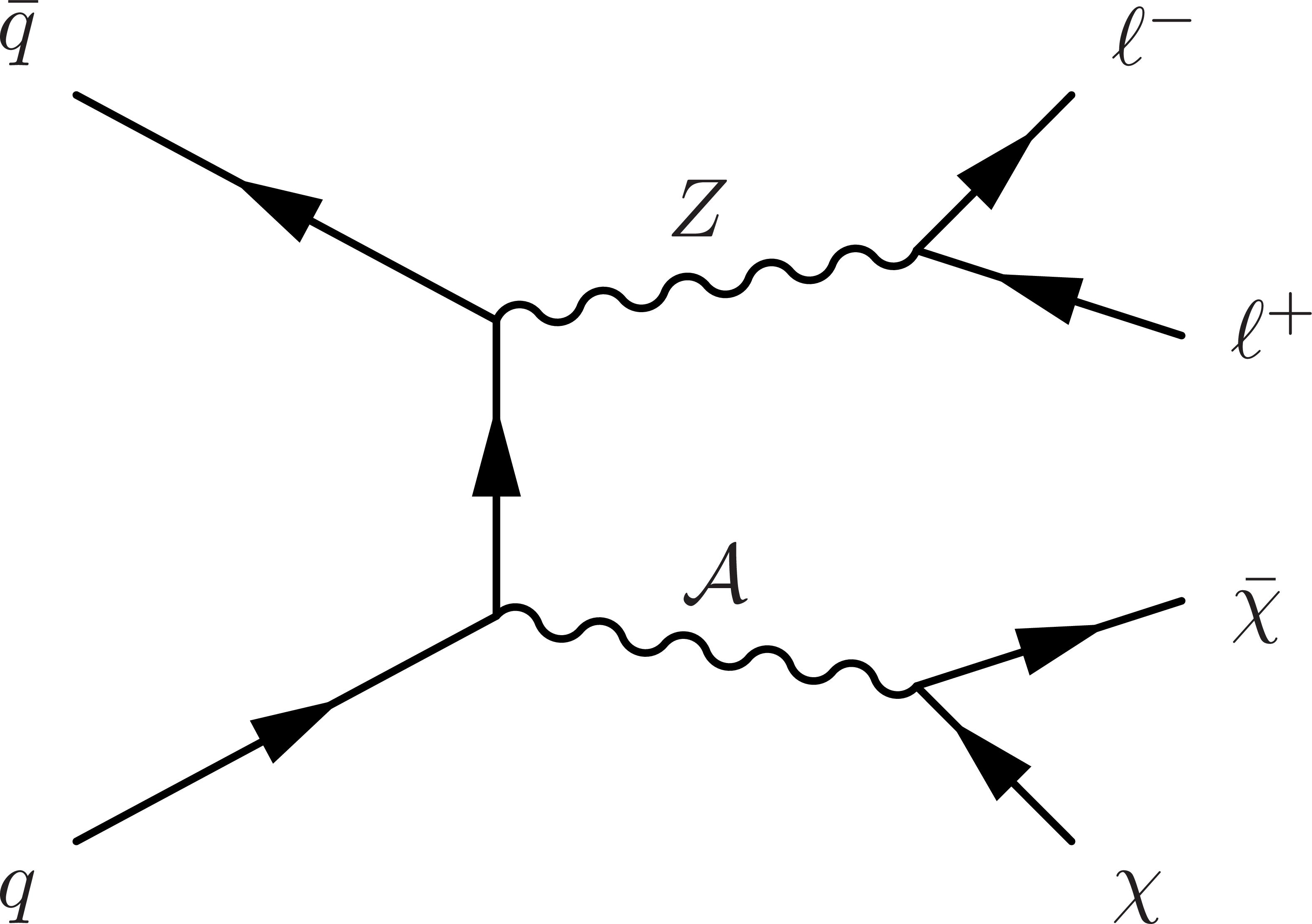
png pdf |
Figure 1-a:
Feynman diagram illustrative of the simplified dark matter model for a spin-1 mediator, which produces a final state of a Z boson that decays into a pair of leptons and missing transverse momentum. Here A represents the DM mediator and $\chi$ represents a DM particle. |
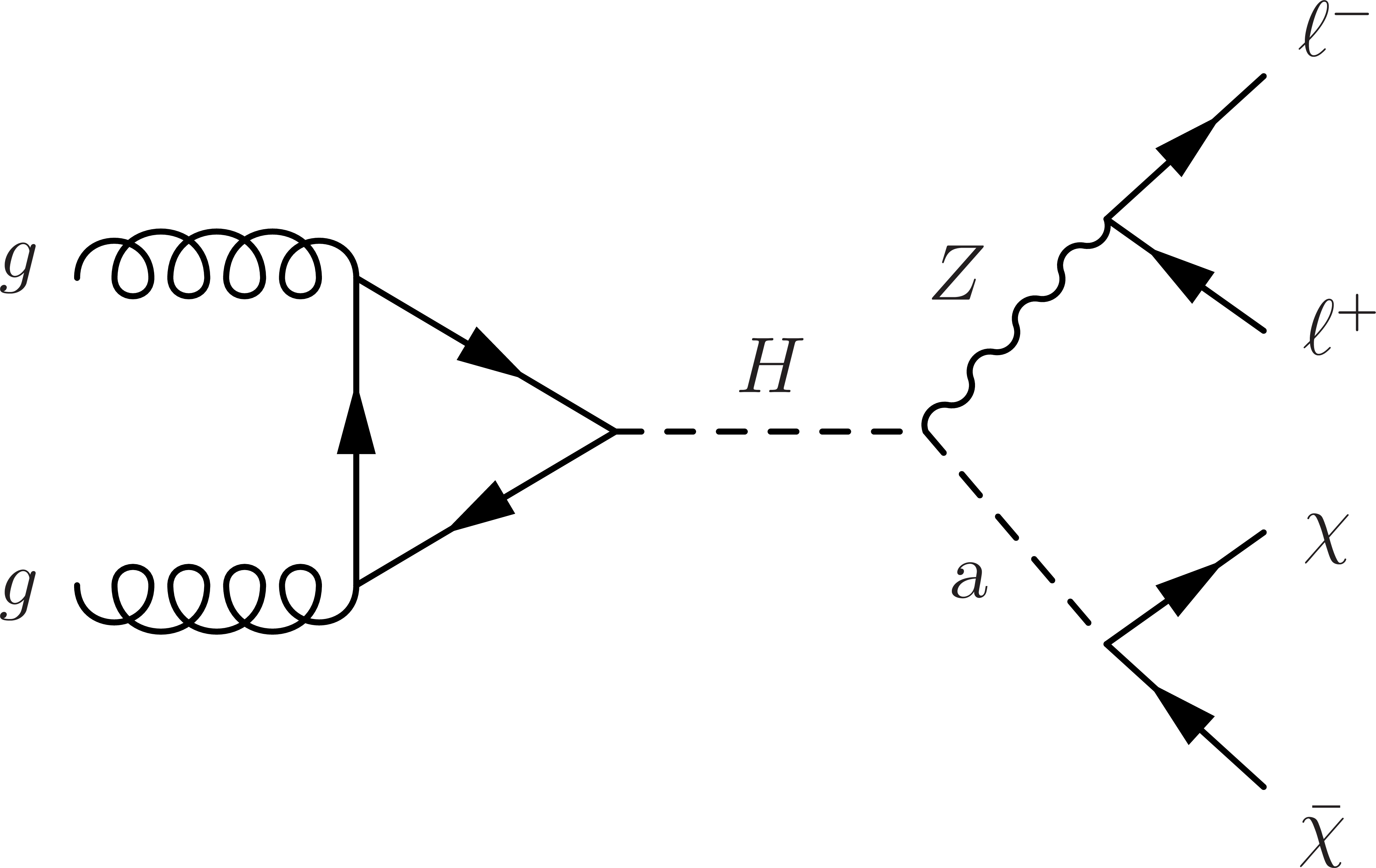
png pdf |
Figure 1-b:
Feynman diagram illustrative of the 2HDM+a model, which produces a final state of a Z boson that decays into a pair of leptons and missing transverse momentum. Here $\chi$ represents a DM particle, while H and a represent the scalar (non SM-like) and pseudoscalar Higgs bosons, respectively. |

png pdf |
Figure 1-c:
Feynman diagram illustrative of the invisible Higgs boson decays, which produces a final state of a Z boson that decays into a pair of leptons and missing transverse momentum. Here $\chi$ represents a DM particle, while h represents the SM-like 125 GeV Higgs boson. |
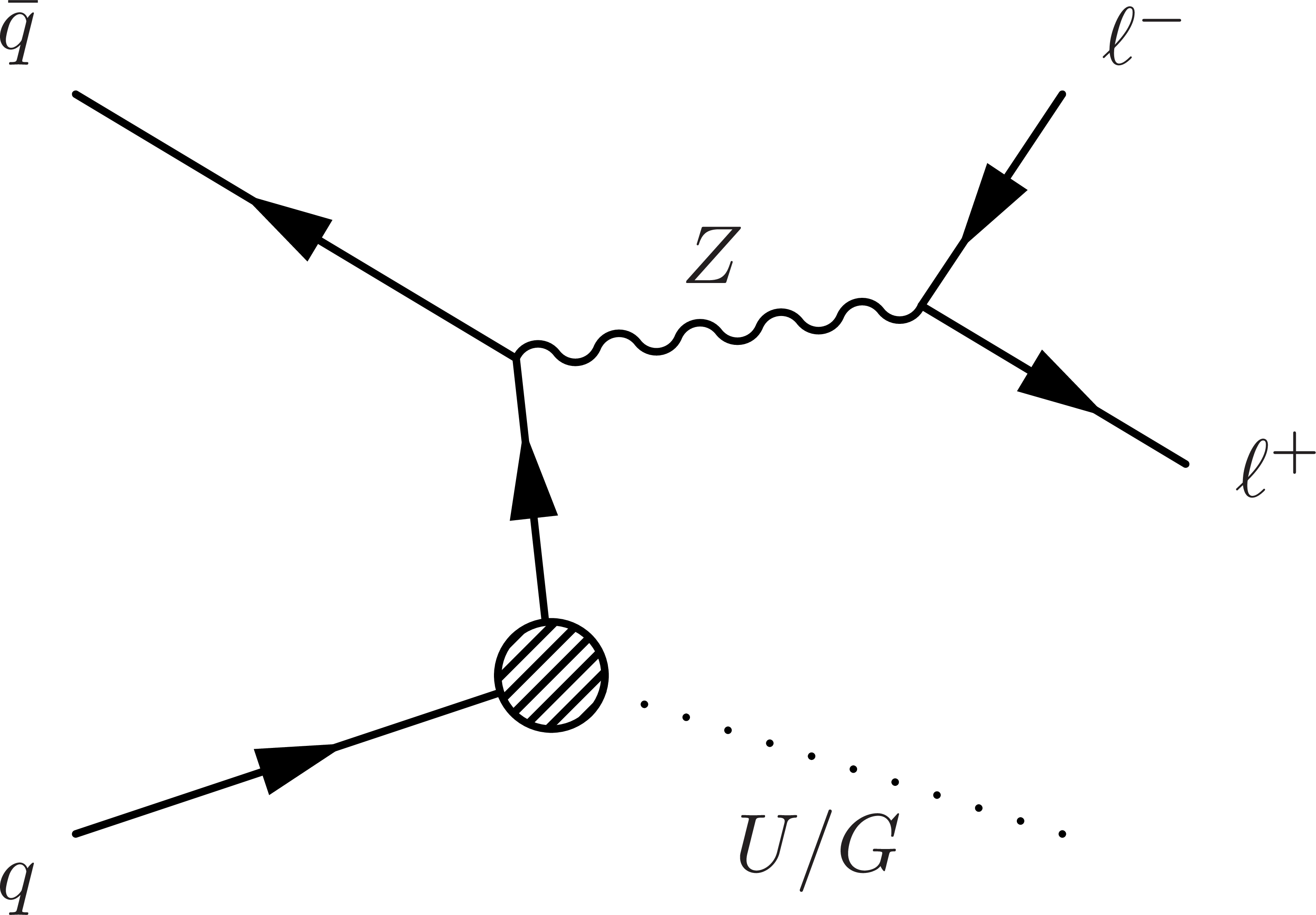
png pdf |
Figure 1-d:
Feynman diagram illustrative of the graviton (G) production in a model with large extra dimensions or unparticle (U) production, which produces a final state of a Z boson that decays into a pair of leptons and missing transverse momentum. Here the dotted line represents either an unparticle or a graviton. |
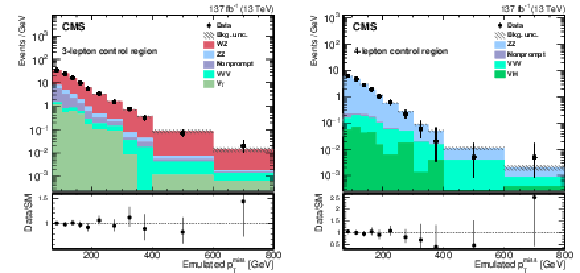
png pdf |
Figure 2:
Emulated ${{p_{\mathrm {T}}} ^\text {miss}}$ distribution in data and simulation for the 3$\ell $ (left) and 4$\ell $ (right) CRs. Uncertainty bands correspond to the postfit combined statistical and systematic components. |
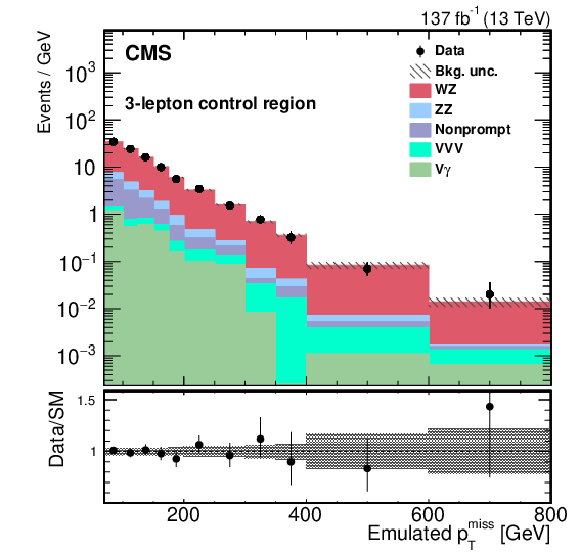
png pdf |
Figure 2-a:
Emulated ${{p_{\mathrm {T}}} ^\text {miss}}$ distribution in data and simulation for the 3$\ell $ CR. Uncertainty bands correspond to the postfit combined statistical and systematic components. |
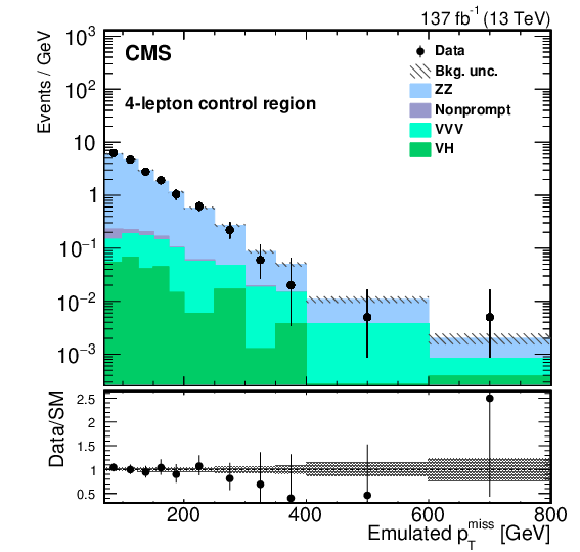
png pdf |
Figure 2-b:
Emulated ${{p_{\mathrm {T}}} ^\text {miss}}$ distribution in data and simulation for the 4$\ell $ CR. Uncertainty bands correspond to the postfit combined statistical and systematic components. |

png pdf |
Figure 3:
The ${{p_{\mathrm {T}}} ^\text {miss}}$ distributions for events in the signal region in the 0-jet (left) and 1-jet (right) categories. The rightmost bin also includes events with $ {{p_{\mathrm {T}}} ^\text {miss}} > $ 800 GeV. The uncertainty band includes both statistical and systematic components. The $\mathrm{Z} \mathrm{h} (\text {invisible})$ signal normalization assumes SM production rates and the branching fraction $\mathcal {B}(\mathrm{h} \to \text {invisible})=$ 1. For the ADD model, the signal normalization assumes the expected values for $n=$ 4 and $M_{\mathrm {D}} = $ 2 TeV. |

png pdf |
Figure 3-a:
The ${{p_{\mathrm {T}}} ^\text {miss}}$ distribution for events in the signal region in the 0-jet category. The rightmost bin also includes events with $ {{p_{\mathrm {T}}} ^\text {miss}} > $ 800 GeV. The uncertainty band includes both statistical and systematic components. The $\mathrm{Z} \mathrm{h} (\text {invisible})$ signal normalization assumes SM production rates and the branching fraction $\mathcal {B}(\mathrm{h} \to \text {invisible})=$ 1. For the ADD model, the signal normalization assumes the expected values for $n=$ 4 and $M_{\mathrm {D}} = $ 2 TeV. |

png pdf |
Figure 3-b:
The ${{p_{\mathrm {T}}} ^\text {miss}}$ distribution for events in the signal region in the 1-jet category. The rightmost bin also includes events with $ {{p_{\mathrm {T}}} ^\text {miss}} > $ 800 GeV. The uncertainty band includes both statistical and systematic components. The $\mathrm{Z} \mathrm{h} (\text {invisible})$ signal normalization assumes SM production rates and the branching fraction $\mathcal {B}(\mathrm{h} \to \text {invisible})=$ 1. For the ADD model, the signal normalization assumes the expected values for $n=$ 4 and $M_{\mathrm {D}} = $ 2 TeV. |

png pdf |
Figure 4:
The ${m_{\mathrm {T}}}$ distributions for events in the signal region in the 0-jet (left) and 1-jet (right) categories. The rightmost bin also includes events with $ {m_{\mathrm {T}}} > $ 1000 GeV. The uncertainty band includes both statistical and systematic components. The signal normalization assumes the expected values for $(m_\mathrm{H},m_{{\textsf {a}}}) = $ (1200,300) GeV within the 2HDM+a framework. |
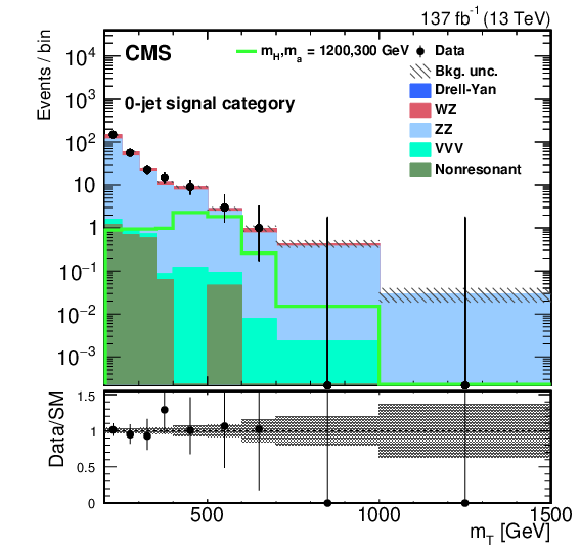
png pdf |
Figure 4-a:
The ${m_{\mathrm {T}}}$ distribution for events in the signal region in the 0-jet category. The rightmost bin also includes events with $ {m_{\mathrm {T}}} > $ 1000 GeV. The uncertainty band includes both statistical and systematic components. The signal normalization assumes the expected values for $(m_\mathrm{H},m_{{\textsf {a}}}) = $ (1200,300) GeV within the 2HDM+a framework. |

png pdf |
Figure 4-b:
The ${m_{\mathrm {T}}}$ distribution for events in the signal region in the 1-jet category. The rightmost bin also includes events with $ {m_{\mathrm {T}}} > $ 1000 GeV. The uncertainty band includes both statistical and systematic components. The signal normalization assumes the expected values for $(m_\mathrm{H},m_{{\textsf {a}}}) = $ (1200,300) GeV within the 2HDM+a framework. |

png pdf |
Figure 5:
The 95% CL exclusion limits for the vector (left) and the axial-vector (right) simplified models. The limits are shown as a function of the mediator and DM particle masses. The coupling to quarks is fixed to $g_{\mathrm{q}}=$ 0.25 and the coupling to DM is set to $g_{\chi}=$ 1. |

png pdf |
Figure 5-a:
The 95% CL exclusion limits for the vector simplified model. The limits are shown as a function of the mediator and DM particle masses. The coupling to quarks is fixed to $g_{\mathrm{q}}=$ 0.25 and the coupling to DM is set to $g_{\chi}=$ 1. |

png pdf |
Figure 5-b:
The 95% CL exclusion limits for the axial-vector simplified model. The limits are shown as a function of the mediator and DM particle masses. The coupling to quarks is fixed to $g_{\mathrm{q}}=$ 0.25 and the coupling to DM is set to $g_{\chi}=$ 1. |

png pdf |
Figure 6:
The 90% CL DM-nucleon upper limits on the cross section for simplified DM in the spin-independent (left) and spin-dependent (right) cases. The coupling to quarks is set to $g_{\mathrm{q}}=$ 0.25 and the coupling to DM is set to $g_{\chi}=$ 1. Limits from the XENON1T [89], LUX [90], PandaX-ll [91], CRESST-III [92], and DarkSide-50 [93] experiments are shown for the spin-independent case with vector couplings. Limits from the PICO-60 [94], PICO-2L [95], IceCube [96], and Super-Kamiokande [97] experiments are shown for the spin-dependent case with axial-vector couplings. |

png pdf |
Figure 6-a:
The 90% CL DM-nucleon upper limits on the cross section for simplified DM in the spin-independent case with vector couplings. The coupling to quarks is set to $g_{\mathrm{q}}=$ 0.25 and the coupling to DM is set to $g_{\chi}=$ 1. Limits from the XENON1T [89], LUX [90], PandaX-ll [91], CRESST-III [92], and DarkSide-50 [93] experiments are shown. |

png pdf |
Figure 6-b:
The 90% CL DM-nucleon upper limits on the cross section for simplified DM in the spin-dependent case with axial-vector couplings. The coupling to quarks is set to $g_{\mathrm{q}}=$ 0.25 and the coupling to DM is set to $g_{\chi}=$ 1. Limits from the PICO-60 [94], PICO-2L [95], IceCube [96], and Super-Kamiokande [97] experiments are shown. |
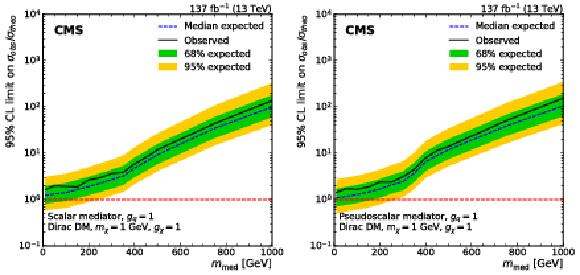
png pdf |
Figure 7:
The 95% CL upper limits on the cross section for simplified DM models with scalar (left) and pseudoscalar (right) mediators. The coupling to quarks is set to $g_{\mathrm{q}}=$ 1, the coupling to DM is set to $g_{\chi}=$ 1 and the DM mass is $m_{\chi}= $ 1 GeV. |

png pdf |
Figure 7-a:
The 95% CL upper limits on the cross section for simplified DM models with scalar mediator. The coupling to quarks is set to $g_{\mathrm{q}}=$ 1, the coupling to DM is set to $g_{\chi}=$ 1 and the DM mass is $m_{\chi}= $ 1 GeV. |

png pdf |
Figure 7-b:
The 95% CL upper limits on the cross section for simplified DM models with pseudoscalar mediator. The coupling to quarks is set to $g_{\mathrm{q}}=$ 1, the coupling to DM is set to $g_{\chi}=$ 1 and the DM mass is $m_{\chi}= $ 1 GeV. |

png pdf |
Figure 8:
The 95% CL upper limits on the 2HDM+a model with the mixing angles set to $\tan(\beta)=$ 1 and $\sin(\theta)=$ 0.35 and with a DM particle mass of $m_{\chi} = $ 10 GeV. The limits are shown as a function of the heavy Higgs boson and the pseudoscalar masses. |
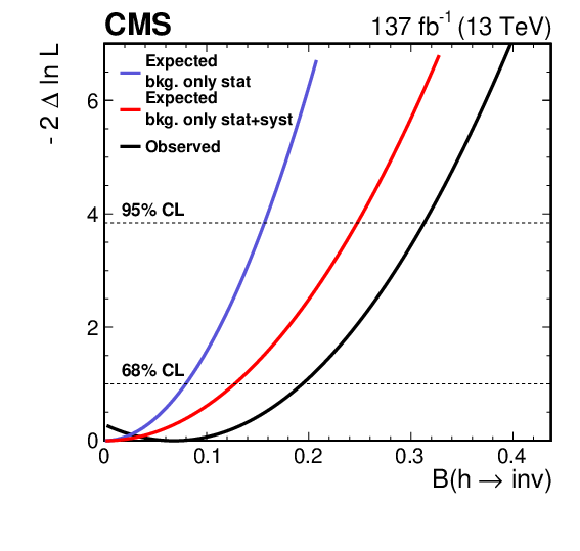
png pdf |
Figure 9:
The value of the negative log-likelihood, $-2\Delta $ln$\mathcal {L}$, as a function of the branching fraction of the Higgs boson decaying to invisible particles. |

png pdf |
Figure 10:
The 95% CL upper limits on unparticle+Z production cross section, as a function of the scaling dimension $d_\textsf {U}$. These limits apply to fixed values of the effective cutoff scale $\lambda _\textsf {U} = $ 15 TeV and coupling $\lambda =$ 1. |

png pdf |
Figure 11:
The 95% CL cross section limit in the ADD scenario as a function of $M_{\mathrm {D}}$ for $n=$ 4. |

png pdf |
Figure 12:
The 95% CL expected and observed exclusion limits on $M_{\mathrm {D}}$ as a function of the number of extra dimensions $n$. |
| Tables | |

png pdf |
Table 1:
Summary of the kinematic selections for the signal region. |
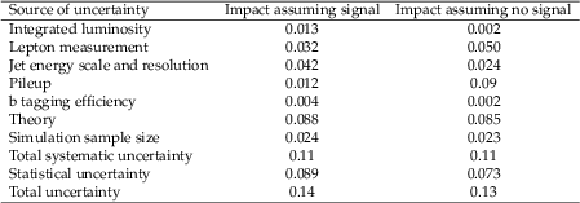
png pdf |
Table 2:
Summary of the uncertainties in the branching fraction arising from the systematic uncertainties considered in the $\mathrm{Z} \mathrm{h} (\text {invisible})$ model assuming $\mathcal {B}(\mathrm{h} \to \text {invisible})=$ 1 (signal) and $\mathcal {B}(\mathrm{h} \to \text {invisible})=$ 0 (no signal). Here, lepton measurement refers to the combined trigger, lepton reconstruction and identification efficiencies, and the lepton momentum and electron energy scale systematic uncertainty. Here, theory uncertainties include variations of the renormalization and factorization scales, $\alpha _{s}$, and PDFs as well as the higher-order EWK corrections. |
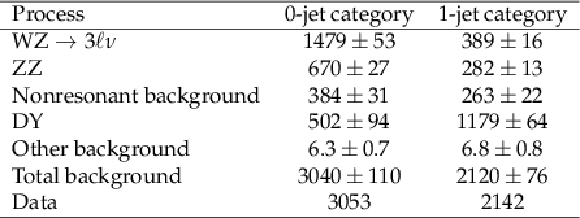
png pdf |
Table 3:
Observed number of events and post-fit background estimates in the two jet multiplicity categories of the SR. The reported uncertainty represents the sum in quadrature of the statistical and systematic components. |

png pdf |
Table 4:
Expected yields and the product of acceptance and efficiency for several models probed in the analysis. The quoted values correspond to the $\mathrm{Z} \to \ell \ell $ decays. The reported uncertainty represents the sum in quadrature of the statistical and systematic components. |
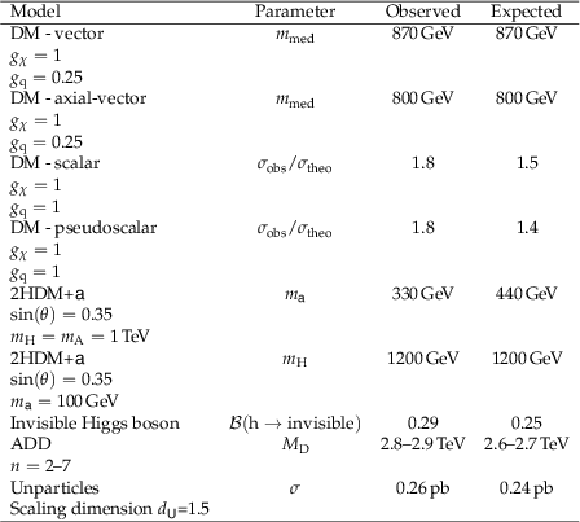
png pdf |
Table 5:
Observed and expected 95% CL limits on parameters for the simplified DM models, invisible decays of the Higgs boson, two-Higgs-doublet model, large extra dimensions in the ADD scenario, and unparticle model. For the scalar and pseudoscalar mediators, the limits are dependent on the mediator mass, so the lowest values for the ratio of observed to theoretical cross sections are presented. For the vector and axial-vector mediators, the limits are dependent on the DM particle mass, so the limits are shown for $m_{\chi}< $ 300 GeV for the vector mediator and $m_{\chi}= $ 240 GeV for the axial-vector mediator. |
| Summary |
| Events with a Z boson recoiling against missing transverse momentum in proton-proton collisions at the LHC are used to search for physics beyond the standard model. The results are interpreted in the context of several different models of the coupling mechanism between dark matter and ordinary matter: simplified models of dark matter with vector, axial-vector, scalar, and pseudoscalar mediators; invisible decays of a standard model-like Higgs boson; and a two-Higgs-doublet model with an extra pseudoscalar. Outside the context of dark matter, models that invoke large extra dimensions or propose the production of unparticles could contribute to the same signature and are also considered. The observed limits on the production cross sections are used to constrain parameters of each of these models. The search utilizes a data set collected by the CMS experiment in 2016-2018, corresponding to an integrated luminosity of 137 fb$^{-1}$ at $\sqrt{s} = $ 13 TeV. No evidence of physics beyond the standard model is observed. Comparing to the previous results in this channel based on a partial data sample collected at $\sqrt{s} = $ 13 TeV in 2016, corresponding to an integrated luminosity of approximately 36 fb$^{-1}$ for CMS [3] and for ATLAS [4], the exclusion limits for simplified dark matter mediators, gravitons and unparticles are significantly extended. For the case of a standard model-like Higgs boson, an upper limit of 29% is set for the branching fraction to fully invisible decays at 95% confidence level. Results for the two-Higgs-doublet model with an additional pseudoscalar are presented in this final state and probe masses of the pseudoscalar mediator up to 440 GeV and of the heavy Higgs boson up to 1200 GeV when the other model parameters are set to specific benchmark values. |
| Additional Figures | |
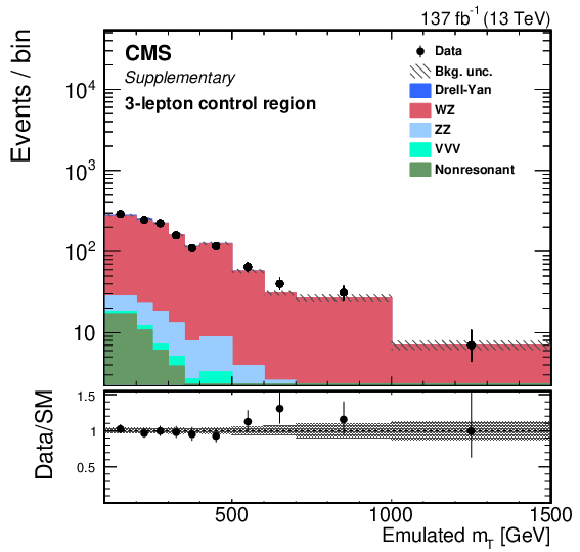
png pdf |
Additional Figure 1:
Emulated ${m_{\mathrm {T}}}$ distribution in data and simulation for the 3$\ell $ control region. Uncertainty bands correspond to the postfit combined statistical and systematic components. The overflow is included in the last bin. The bottom panel in each figure shows the ratio of the number of events observed in data to that of the total SM prediction. The gray bands represent the uncertainties in the predicted yields. The vertical bars represent the statistical uncertainties in the data. |
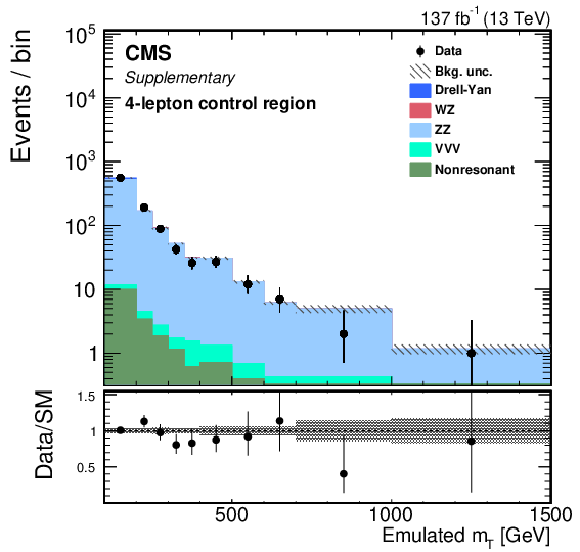
png pdf |
Additional Figure 2:
Emulated ${m_{\mathrm {T}}}$ distribution in data and simulation for the 4$\ell $ control region. Uncertainty bands correspond to the postfit combined statistical and systematic components. The overflow is included in the last bin. The bottom panel in each figure shows the ratio of the number of events observed in data to that of the total SM prediction. The gray bands represent the uncertainties in the predicted yields. The vertical bars represent the statistical uncertainties in the data. |
| References | ||||
| 1 | G. Bertone and D. Hooper | History of dark matter | Rev. Mod. Phys. 90 (2018) 045002 | 1605.04909 |
| 2 | Planck Collaboration | Planck 2018 results. I. overview and the cosmological legacy of Planck | 1807.06205 | |
| 3 | CMS Collaboration | Search for new physics in events with a leptonically decaying $ \mathrm{Z} $ boson and a large transverse momentum imbalance in proton-proton collisions at $ \sqrt{s} = $ 13 TeV | EPJC 78 (2018) 291 | CMS-EXO-16-052 1711.00431 |
| 4 | ATLAS Collaboration | Search for an invisibly decaying Higgs boson or dark matter candidates produced in association with a $ \mathrm{Z} $ boson in $ {\mathrm{p}}{\mathrm{p}} $ collisions at $ \sqrt{s} = $ 13 TeV with the ATLAS detector | PLB 776 (2018) 318 | 1708.09624 |
| 5 | ATLAS Collaboration | Search for dark matter and other new phenomena in events with an energetic jet and large missing transverse momentum using the ATLAS detector | JHEP 01 (2018) 126 | 1711.03301 |
| 6 | CMS Collaboration | Search for new physics in final states with an energetic jet or a hadronically decaying $ \mathrm{W} $ or $ \mathrm{Z} $ boson and transverse momentum imbalance at $ \sqrt{s}= $ 13 TeV | PRD 97 (2018) 092005 | CMS-EXO-16-048 1712.02345 |
| 7 | ATLAS Collaboration | Search for dark matter at $ \sqrt{s}= $ 13 TeV in final states containing an energetic photon and large missing transverse momentum with the ATLAS detector | EPJC 77 (2017) 393 | 1704.03848 |
| 8 | CMS Collaboration | Search for new physics in the monophoton final state in proton-proton collisions at $ \sqrt{s}= $ 13 TeV | JHEP 10 (2017) 073 | CMS-EXO-16-039 1706.03794 |
| 9 | ATLAS Collaboration | Search for dark matter produced in association with bottom or top quarks in $ \sqrt{s}=13 TeV {\mathrm{p}}{\mathrm{p}} $ collisions with the ATLAS detector | EPJC 78 (2018) 18 | 1710.11412 |
| 10 | CMS Collaboration | Search for dark matter in events with energetic, hadronically decaying top quarks and missing transverse momentum at $ \sqrt{s}= $ 13 TeV | JHEP 06 (2018) 027 | CMS-EXO-16-051 1801.08427 |
| 11 | ATLAS Collaboration | Search for dark matter in events with a hadronically decaying vector boson and missing transverse momentum in $ {\mathrm{p}}{\mathrm{p}} $ collisions at $ \sqrt{s} = $ 13 TeV with the ATLAS detector | JHEP 10 (2018) 180 | 1807.11471 |
| 12 | ATLAS Collaboration | Search for dark matter in events with missing transverse momentum and a higgs boson decaying to two photons in $ {\mathrm{p}}{\mathrm{p}} $ collisions at $ \sqrt{s}= $ 8 TeV with the ATLAS detector | PRL 115 (2015) 131801 | 1506.01081 |
| 13 | ATLAS Collaboration | Search for dark matter produced in association with a Higgs boson decaying to two bottom quarks in $ {\mathrm{p}}{\mathrm{p}} $ collisions at $ \sqrt{s} = $ 8 TeV with the ATLAS detector | PRD 93 (2016) 072007 | 1510.06218 |
| 14 | ATLAS Collaboration | Search for dark matter in association with a Higgs boson decaying to $ b $-quarks in $ {\mathrm{p}}{\mathrm{p}} $ collisions at $ \sqrt s= $ 13 TeV with the ATLAS detector | PLB 765 (2017) 11 | 1609.04572 |
| 15 | CMS Collaboration | Search for associated production of dark matter with a Higgs boson decaying to $ \mathrm{b}\overline{\mathrm{b}} $ or $ \gamma \gamma $ at $ \sqrt{s}= $ 13 TeV | JHEP 10 (2017) 180 | CMS-EXO-16-012 1703.05236 |
| 16 | ATLAS Collaboration | Search for dark matter in association with a Higgs boson decaying to two photons at $ \sqrt{s} = $ 13 TeV with the atlas detector | PRD 96 (2017) 112004 | 1706.03948 |
| 17 | ATLAS Collaboration | Search for dark matter produced in association with a Higgs boson decaying to $ b\bar b $ using 36 fb$ ^{-1} $ of $ {\mathrm{p}}{\mathrm{p}} $ collisions at $ \sqrt{s}= $ 13 TeV with the ATLAS detector | PRL 119 (2017) 181804 | 1707.01302 |
| 18 | CMS Collaboration | Search for heavy resonances decaying into a vector boson and a Higgs boson in final states with charged leptons, neutrinos and b quarks at $ \sqrt{s}= $ 13 TeV | JHEP 11 (2018) 172 | CMS-B2G-17-004 1807.02826 |
| 19 | CMS Collaboration | Search for dark matter produced in association with a Higgs boson decaying to a pair of bottom quarks in proton-proton collisions at $ \sqrt{s}= $ 13 TeV | EPJC 79 (2019) 280 | CMS-EXO-16-050 1811.06562 |
| 20 | CMS Collaboration | Search for dark matter produced in association with a Higgs boson decaying to $ \gamma\gamma $ or $ \tau^+\tau^- $ at $ \sqrt{s} = $ 13 TeV | JHEP 09 (2018) 046 | CMS-EXO-16-055 1806.04771 |
| 21 | CMS Collaboration | Search for dark matter particles produced in association with a Higgs boson in proton-proton collisions at $ \sqrt{s} = $ 13 TeV | JHEP 03 (2020) 025 | CMS-EXO-18-011 1908.01713 |
| 22 | D. Abercrombie et al. | Dark matter benchmark models for early LHC Run-2 searches: report of the ATLAS/CMS dark matter forum | Phys. Dark Univ. 27 (2020) 100371 | 1507.00966 |
| 23 | G. Busoni et al. | Recommendations on presenting LHC searches for missing transverse energy signals using simplified $ s $-channel models of dark matter | Phys. Dark Univ. 27 (2020) 100365 | 1603.04156 |
| 24 | M. Bauer, U. Haisch, and F. Kahlhoefer | Simplified dark matter models with two Higgs doublets: I. pseudoscalar mediators | JHEP 05 (2017) 138 | 1701.07427 |
| 25 | LHC Dark Matter Working Group Collaboration | LHC Dark Matter Working Group: next-generation spin-0 dark matter models | Phys. Dark Univ. 27 (2020) 100351 | 1810.09420 |
| 26 | S. Baek, P. Ko, W.-I. Park, and E. Senaha | Higgs portal vector dark matter : revisited | JHEP 05 (2013) 036 | 1212.2131 |
| 27 | A. Djouadi, O. Lebedev, Y. Mambrini, and J. Quevillon | Implications of LHC searches for Higgs--portal dark matter | PLB 709 (2012) 65 | 1112.3299 |
| 28 | A. Djouadi, A. Falkowski, Y. Mambrini, and J. Quevillon | Direct detection of Higgs-portal dark matter at the LHC | EPJC 73 (2013) 2455 | 1205.3169 |
| 29 | G. Arcadi, A. Djouadi, and M. Raidal | Dark matter through the Higgs portal | PR 842 (2020) 1 | 1903.03616 |
| 30 | G. Belanger et al. | The MSSM invisible Higgs in the light of dark matter and g-2 | PLB 519 (2001) 93 | hep-ph/0106275 |
| 31 | H. Georgi | Unparticle physics | PRL 98 (2007) 221601 | hep-ph/0703260 |
| 32 | H. Georgi | Another odd thing about unparticle physics | PLB 650 (2007) 275 | 0704.2457 |
| 33 | Z. Kang | Upgrading sterile neutrino dark matter to FI$ m $P using scale invariance | EPJC 75 (2015) 471 | 1411.2773 |
| 34 | M. Rinaldi, G. Cognola, L. Vanzo, and S. Zerbini | Inflation in scale-invariant theories of gravity | PRD 91 (2015) 123527 | 1410.0631 |
| 35 | H. Cheng | The possible existence of Weyl's vector meson | PRL 61 (1988) 2182 | |
| 36 | T. Banks and A. Zaks | On the phase structure of vector-like gauge theories with massless fermions | NPB 196 (1982) 189 | |
| 37 | K. Cheung, W.-Y. Keung, and T.-C. Yuan | Collider signals of unparticle physics | PRL 99 (2007) 051803 | 0704.2588 |
| 38 | N. Arkani-Hamed, S. Dimopoulos, and G. R. Dvali | The hierarchy problem and new dimensions at a millimeter | PLB 429 (1998) 263 | hep-ph/9803315 |
| 39 | T. Han, J. D. Lykken, and R. Zhang | On Kaluza-Klein states from large extra dimensions | PRD 59 (1999) 105006 | hep-ph/9811350 |
| 40 | CMS Collaboration | The CMS trigger system | JINST 12 (2017) P01020 | CMS-TRG-12-001 1609.02366 |
| 41 | CMS Collaboration | The CMS experiment at the CERN LHC | JINST 3 (2008) S08004 | CMS-00-001 |
| 42 | O. Mattelaer and E. Vryonidou | Dark matter production through loop-induced processes at the LHC: the s-channel mediator case | EPJC 75 (2015) 436 | 1508.00564 |
| 43 | M. Neubert, J. Wang, and C. Zhang | Higher-order QCD predictions for dark matter production in mono-$ \mathrm{Z} $ searches at the LHC | JHEP 02 (2016) 082 | 1509.05785 |
| 44 | J. Alwall et al. | The automated computation of tree-level and next-to-leading order differential cross sections, and their matching to parton shower simulations | JHEP 07 (2014) 079 | 1405.0301 |
| 45 | R. Frederix and S. Frixione | Merging meets matching in MC@NLO | JHEP 12 (2012) 061 | 1209.6215 |
| 46 | P. Artoisenet, R. Frederix, O. Mattelaer, and R. Rietkerk | Automatic spin-entangled decays of heavy resonances in Monte Carlo simulations | JHEP 03 (2013) 015 | 1212.3460 |
| 47 | J. Alwall et al. | Comparative study of various algorithms for the merging of parton showers and matrix elements in hadronic collisions | EPJC 53 (2008) 473 | 0706.2569 |
| 48 | P. Nason | A new method for combining NLO QCD with shower Monte Carlo algorithms | JHEP 11 (2004) 040 | hep-ph/0409146 |
| 49 | S. Frixione, P. Nason, and C. Oleari | Matching NLO QCD computations with parton shower simulations: the POWHEG method | JHEP 11 (2007) 070 | 0709.2092 |
| 50 | S. Alioli, P. Nason, C. Oleari, and E. Re | A general framework for implementing NLO calculations in shower Monte Carlo programs: the POWHEG BOX | JHEP 06 (2010) 043 | 1002.2581 |
| 51 | S. Frixione, P. Nason, and G. Ridolfi | A positive-weight next-to-leading-order Monte Carlo for heavy flavour hadroproduction | JHEP 09 (2007) 126 | 0707.3088 |
| 52 | E. Bagnaschi, G. Degrassi, P. Slavich, and A. Vicini | Higgs production via gluon fusion in the POWHEG approach in the SM and in the MSSM | JHEP 02 (2012) 088 | 1111.2854 |
| 53 | LHC Higgs Cross Section Working Group | Handbook of LHC Higgs cross sections: 4. deciphering the nature of the Higgs sector | CERN (2016) | 1610.07922 |
| 54 | T. Sjostrand et al. | An introduction to PYTHIA 8.2 | CPC 191 (2015) 159 | 1410.3012 |
| 55 | S. Ask et al. | Real emission and virtual exchange of gravitons and unparticles in Pythia8 | CPC 181 (2010) 1593 | 0912.4233 |
| 56 | S. Ask | Simulation of $ \mathrm{Z} $ plus graviton/unparticle production at the LHC | EPJC 60 (2009) 509 | 0809.4750 |
| 57 | NNPDF Collaboration | Parton distributions from high-precision collider data | EPJC 77 (2017) 663 | 1706.00428 |
| 58 | CMS Collaboration | Event generator tunes obtained from underlying event and multiparton scattering measurements | EPJC 76 (2016) 155 | CMS-GEN-14-001 1512.00815 |
| 59 | CMS Collaboration | Extraction and validation of a new set of CMS PYTHIA8 tunes from underlying-event measurements | EPJC 80 (2020) 4 | CMS-GEN-17-001 1903.12179 |
| 60 | \GEANTfour Collaboration | GEANT4 --- a simulation toolkit | NIMA 506 (2003) 250 | |
| 61 | CMS Collaboration | Pileup mitigation at CMS in 13 TeV data | (3, 2020). Submitted to JINST | CMS-JME-18-001 2003.00503 |
| 62 | CMS Collaboration | Particle-flow reconstruction and global event description with the CMS detector | JINST 12 (2017) P10003 | CMS-PRF-14-001 1706.04965 |
| 63 | M. Cacciari, G. P. Salam, and G. Soyez | The anti-$ {k_{\mathrm{T}}} $ jet clustering algorithm | JHEP 04 (2008) 063 | 0802.1189 |
| 64 | M. Cacciari, G. P. Salam, and G. Soyez | FastJet user manual | EPJC 72 (2012) 1896 | 1111.6097 |
| 65 | CMS Collaboration | Performance of photon reconstruction and identification with the CMS detector in proton-proton collisions at sqrt(s) = 8 TeV | JINST 10 (2015) P08010 | CMS-EGM-14-001 1502.02702 |
| 66 | CMS Collaboration | Performance of the CMS muon detector and muon reconstruction with proton-proton collisions at $ \sqrt{s} = $ 13 TeV | JINST 13 (2018) P06015 | CMS-MUO-16-001 1804.04528 |
| 67 | CMS Collaboration | Jet energy scale and resolution in the CMS experiment in pp collisions at 8 TeV | JINST 12 (2017) P02014 | CMS-JME-13-004 1607.03663 |
| 68 | CMS Collaboration | Jet algorithms performance in 13 TeV data | CMS-PAS-JME-16-003 | CMS-PAS-JME-16-003 |
| 69 | CMS Collaboration | Identification of heavy-flavour jets with the CMS detector in pp collisions at 13 TeV | JINST 13 (2018) P05011 | CMS-BTV-16-002 1712.07158 |
| 70 | CMS Collaboration | Performance of reconstruction and identification of $ \tau $ leptons decaying to hadrons and $ \nu_\tau $ in pp collisions at $ \sqrt{s}= $ 13 TeV | JINST 13 (2018) P10005 | CMS-TAU-16-003 1809.02816 |
| 71 | CMS Collaboration | Performance of missing transverse momentum reconstruction in proton-proton collisions at $ \sqrt{s} = $ 13 TeV using the CMS detector | JINST 14 (2019) P07004 | CMS-JME-17-001 1903.06078 |
| 72 | Particle Data Group, M. Tanabashi et al. | Review of particle physics | PRD 98 (2018) 030001 | |
| 73 | The ATLAS Collaboration, the CMS Collaboration, and the LHC Higgs Combination Group | Procedure for the LHC Higgs boson search combination in Summer 2011 | CMS-NOTE-2011-005 | |
| 74 | CMS Collaboration | CMS luminosity measurement for the 2016 data-taking period | CMS-PAS-LUM-15-001 | CMS-PAS-LUM-15-001 |
| 75 | CMS Collaboration | CMS luminosity measurement for the 2017 data-taking period at $ \sqrt{s} = $ 13 TeV | CMS-PAS-LUM-17-004 | CMS-PAS-LUM-17-004 |
| 76 | CMS Collaboration | CMS luminosity measurement for the 2018 data-taking period at $ \sqrt{s} = $ 13 TeV | CMS-PAS-LUM-18-002 | CMS-PAS-LUM-18-002 |
| 77 | CMS Collaboration | Performance of electron reconstruction and selection with the CMS detector in proton-proton collisions at $ \sqrt{s} = $ 8 TeV | JINST 10 (2015) P06005 | CMS-EGM-13-001 1502.02701 |
| 78 | CMS Collaboration | Measurements of differential $ \mathrm{Z} $ boson production cross sections in proton-proton collisions at $ \sqrt{s} = $ 13 TeV | JHEP 12 (2019) 061 | CMS-SMP-17-010 1909.04133 |
| 79 | CMS Collaboration | Measurement of the inelastic proton-proton cross section at $ \sqrt{s}= $ 13 TeV | JHEP 07 (2018) 161 | CMS-FSQ-15-005 1802.02613 |
| 80 | J. Rojo et al. | The PDF4LHC report on PDFs and LHC data: Results from Run I and preparation for Run II | JPG 42 (2015) 103103 | 1507.00556 |
| 81 | J. Butterworth et al. | PDF4LHC recommendations for LHC Run II | JPG 43 (2016) 023001 | 1510.03865 |
| 82 | A. Accardi et al. | A critical appraisal and evaluation of modern PDFs | EPJC 76 (2016) 471 | 1603.08906 |
| 83 | A. Bierweiler, T. Kasprzik, and J. H. Kuhn | Vector-boson pair production at the LHC to $ \mathcal{O}(\alpha^3) $ accuracy | JHEP 12 (2013) 071 | 1305.5402 |
| 84 | S. Gieseke, T. Kasprzik, and J. H. Kahn | Vector-boson pair production and electroweak corrections in HERWIG++ | EPJC 74 (2014) 2988 | 1401.3964 |
| 85 | A. L. Read | Presentation of search results: the CLs technique | JPG: Nucl. Part. Phys. 28 (2002) 2693 | |
| 86 | T. Junk | Confidence level computation for combining searches with small statistics | NIMA 434 (1999) 435 | |
| 87 | L. Demortier | P values and nuisance parameters | in Statistical issues for LHC physics. Proceedings, Workshop, PHYSTAT-LHC, Geneva, 2007 | |
| 88 | A. Albert et al. | Recommendations of the LHC Dark Matter Working Group: Comparing LHC searches for dark matter mediators in visible and invisible decay channels and calculations of the thermal relic density | Phys. Dark Univ. 26 (2019) 100377 | 1703.05703 |
| 89 | XENON Collaboration | Dark matter search results from a one ton-year exposure of XENON1T | PRL 121 (2018) 111302 | 1805.12562 |
| 90 | LUX Collaboration | Results from a search for dark matter in the complete LUX exposure | PRL 118 (2017) 021303 | 1608.07648 |
| 91 | PandaX-II Collaboration | Dark matter results from 54-ton-day exposure of PandaX-II experiment | PRL 119 (2017) 181302 | 1708.06917 |
| 92 | CRESST Collaboration | First results from the CRESST-III low-mass dark matter program | PRD 100 (2019) 102002 | 1904.00498 |
| 93 | DarkSide Collaboration | Low-mass dark matter search with the DarkSide-50 experiment | PRL 121 (2018) 081307 | 1802.06994 |
| 94 | PICO Collaboration | Dark matter search results from the complete exposure of the PICO-60 C$ _3 $F$ _8 $ bubble chamber | PRD 100 (2019) 022001 | 1902.04031 |
| 95 | PICO Collaboration | Improved dark matter search results from PICO-2L Run 2 | PRD 93 (2016) 061101 | 1601.03729 |
| 96 | IceCube Collaboration | Improved limits on dark matter annihilation in the sun with the 79-string IceCube detector and implications for supersymmetry | JCAP 04 (2016) 022 | 1601.00653 |
| 97 | Super-Kamiokande Collaboration | Search for neutrinos from annihilation of captured low-mass dark matter particles in the Sun by Super-Kamiokande | PRL 114 (2015) 141301 | 1503.04858 |
| 98 | ATLAS Collaboration | Constraints on mediator-based dark matter and scalar dark energy models using $ \sqrt s = 13 TeV {\mathrm{p}}{\mathrm{p}} $ collision data collected by the ATLAS detector | JHEP 05 (2019) 142 | 1903.01400 |
| 99 | LHC Higgs Cross Section Working Group | Handbook of LHC Higgs Cross Sections: 3. Higgs Properties | CERN (2013) | 1307.1347 |
| 100 | R. V. Harlander, J. Klappert, S. Liebler, and L. Simon | vh@nnlo-v2: new physics in Higgs strahlung | JHEP 05 (2018) 089 | 1802.04817 |
| 101 | CMS Collaboration | Search for invisible decays of a Higgs boson produced through vector boson fusion in proton-proton collisions at $ \sqrt{s} = $ 13 TeV | PLB 793 (2019) 520 | CMS-HIG-17-023 1809.05937 |
| 102 | ATLAS Collaboration | Combination of searches for invisible Higgs boson decays with the ATLAS experiment | PRL 122 (2019) 231801 | 1904.05105 |

|
Compact Muon Solenoid LHC, CERN |

|

|

|

|

|

|